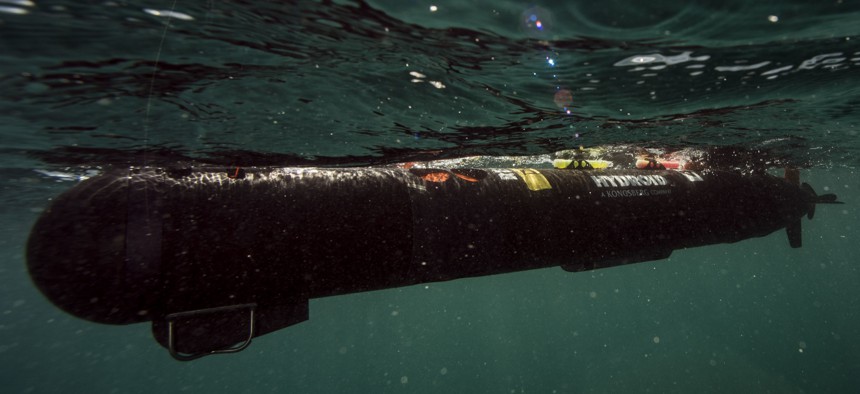
ARABIAN GULF (Sept. 28, 2016) Sailors assigned to Commander, Task Group (CTG) 56.1, Explosive Ordnance Disposal Mobile Unit (EODMU) 1, launch an underwater unmanned vehicle in the Arabian Gulf during routine testing operations. U.S. Navy photo by Petty Officer 2nd Class Tyler Thompson
The US Navy Is Developing Mothership Drones for Coastal Defense
The service is looking to accelerate the way it buys, builds and drills drones and robotic ships.
The U.S. Navy and researchers from Florida Atlantic University are developing robotic boats that can launch aerial and sub drones to protect U.S. coastal waters.
"Our focus will be on developing a multi-vehicle system that can safely and reliably navigate coastal waters with a high level of autonomy while performing assigned tasks," Manhar Dhanak, director of SeaTech, the Institute for Ocean and Systems Engineering in FAU's Department of Ocean and Mechanical Engineering, said in a press release.
The FAU researchers will develop new software tools for better sensing and collision avoidance as well as to allow the ship "to serve as a docking station” and power sub and air drones that latch onto it, according to a statement from the university. One aspect of the effort is developing software to help the surface vessel obtain a clear picture not just of obstacles to avoid but also friendly and hostile elements in the area, to help it better plan routes and paths for different missions.
It’s an example of the types of prototypes that will become more common, according to a Navy roadmap for the development and acquisition of autonomous systems. This Strategic Roadmap for Unmanned Systems, which began circulating around the Pentagon last year, has not yet been released. But a predecisional copy obtained by Defense One shows that the Navy is pushing to develop and buy its drones faster, integrate them more aggressively in exercises and other activity, and work more closely with universities and other non-traditional research partners particularly in the design of new prototypes.
The Navy’s research into unmanned weapons goes back to World War I research into flying munitions and torpedos. The term “drone” was coined in the 1930s by Cmdr. Delmar Fahrney, who was in charge of Navy research into radio-controlled aircraft.
More recently, the Navy has sought to incorporate ever-higher levels of autonomy into drills and activity. In 2014, the service ran a dramatic experiment that showed that a swarm of 13 autonomous roboticized boats might help defend a warship.
The Navy has also developed (and plans to soon deploy) the Sea Hunter, an unmanned ship that can guide itself on the open water while obeying international maritime laws. Former Defense Undersecretary Bob Work speculated that the Sea Hunter could be armed with missiles. "We might be able to put a six-pack or a four-pack of missiles on them. Now, imagine 50 of these distributed and operating together under the hands of a flotilla commander," Work said at an event sponsored by CNAS. "This is going to be a Navy unlike any navy in history, a human-machine collaborative battle fleet that will confound our enemies."
The Navy is experimenting with a widening menagerie of novel aerial drones, such as a tube-launched rotary-wing drone called the Nomad, which was launched off of the destroyer Pinckney in2016. Another is the hybrid flying-swimming Glider, a drone that can deploy from a plane, fly along the surface of the water, and then submerge to a depth of 200 meters.
Flight-testing for a new version of Glider is scheduled for later this year, and the Naval Research Laboratory expects to a full demonstration in 2019.
The new Navy roadmap argues that the service’s adoption of unmanned and robotic capabilities must move far more quickly than it buys human-operated planes, boats, and ships. It outlines steps to accelerate their building, buying and deploying.
One key is moving away from a “platform-centric model” — think big, expensive ships that only serve one role. Instead, envision small, cheap robots that can be robustly networked and easily configured to new tasks.
“The Navy must evolve from today’s platform-centric, uncontested-environment [unmanned systems] operating concept to the concept of a platform-agnostic force,” it says. “A cross-domain, distributed, netted, self-healing, highly survivable, and collaborative communications network made of manned and unmanned nodes will enable multi-domain communications. These nodes will fuse big data to interpret the environment, share relevant information, and introduce increased risk, uncertainty, and mistrust in the adversary’s systems.”
Marcus Weisgerber contributed to this post.
NEXT STORY: How the NGA Sped Up Its Tech Acquisition
